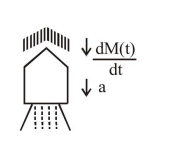A spaceship in space sweeps stationary interplanetary dust. As a result, its mass
increases at a rate $\frac{\mathrm{dM}(\mathrm{t})}{\mathrm{dt}}=\mathrm{bv}^{2}(\mathrm{t})$, where $\mathrm{v}(\mathrm{t})$
is its instantaneous velocity. The instantaneous acceleration of the satellite is:
Correct Option: , 4
$\frac{\mathrm{dm}(\mathrm{t})}{\mathrm{dt}}=\mathrm{bv}^{2}$'
$\mathrm{F}_{\text {thast }}=\mathrm{v} \frac{\mathrm{dm}}{\mathrm{dt}}$'
Force on statellile $=-\overrightarrow{\mathrm{v}} \frac{\mathrm{dm}(\mathrm{t})}{\mathrm{dt}}$
$\mathrm{M}(\mathrm{t}) \mathrm{a}=-\mathrm{v}\left(\mathrm{bv}^{2}\right)$
$a=a \frac{b v^{3}}{M(t)}$

Click here to get exam-ready with eSaral
For making your preparation journey smoother of JEE, NEET and Class 8 to 10, grab our app now.
